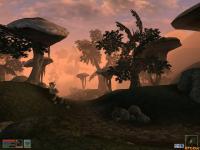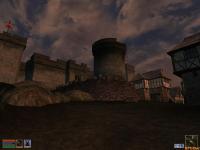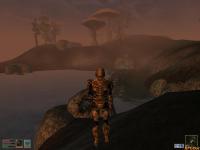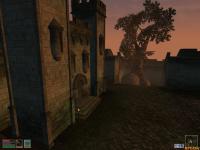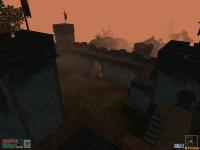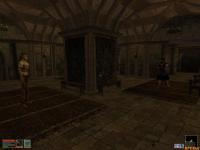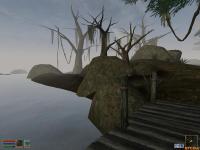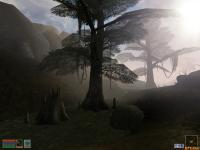|
|
|
Main News Forums Games Games Database Top 100 Release List Support Files Features Reviews Previews Interviews Editorials Diaries Misc Download Gallery Music Screenshots Videos Miscellaneous Staff Members Privacy Statement |
Morrowind Preview Part 2 Rendelius,
2002-04-24 (The second part of a four part preview of Bethesda Softworks' upcoming RPG) The developers said it over and over again: the world of Morrowind is huge. They never answered HOW huge it is, and this is for a good reason. We think that even for those who created it, this is impossible to answer. Yes, you could talk about how long it takes you to get from the south coast to the north coast of Vvardenfall, if you walk in a straight line and if you aren't distracted by sights or monsters. But: you will never get from A to B walking in a straight line. First of all, there are impassable mountains (at least for a beginning character not able to levitate). Second, you will always be distracted by something. We suppose that it would take you several hundred hours to explore each and every bit of the landscape, and we doubt that by following just the main quest you would be able to do so. So: The world is large, and you will spend months to see it all.
What makes Vvardenfall even bigger from a subjective standpoint is the fact that the game is completely non-linear. From most RPGs, we are used to a main storyline with more or less branches leading into subquests. While Dungeon Siege, for example, is very linear (in fact, you have to follow a path throughout the game), and Baldur's Gate was quite linear in some way, too (you were able to enter regions at will, but they were designed to serve the main plot in most cases), Morrowind gives you total freedom to roam the countryside as you wish. Let us give you an example: when you start the game, you have to take the first quest of the main storyline, but you don't have to even start it. You may decide to do some sightseeing, to explore the region where you started, to go to a specific city and make your living there, to earn some money by collecting herbs or to train you skills by hunting animals. You may even start a carreer as a thief, and the developers say it is even possible to play the biggest bad-ass of all times, slaughtering the whole population and rule an island that has no more inhabitants but critters. It is all up to you, and if you never played a game like this, you will be overwhelmed by your possibilities.
The world is yours in Morrowind, and you decide what to do. But how is this world? If you have played Daggerfall, you will remember that its world was huge (in fact, was so huge that the whole island of Morrowind would fit in a single province there), but repetetive and rather void. In Daggerfall, you walked an hour or more from city to city, but apart from a random encounter or so, there wasn't really something that caught your attention. This was the reason why only few people ever walked, and the quick transportation from one city to another was the choice of nearly everybody. Quick transportation is in Morrowind as well, But do yourself a favor and walk whenever you can. Every little inch of the island has been hand crafted, and every little inch has its own beauty. Ther region where you start (all in all, there are nine regions in Morrowind, with a specific look and different plants/animals) will look most familiar to you, although there are mushroom shaped trees and critters unlike those seen in other roleplaying games. Walking lets you enjoy the most spectacular views, and if you walk around, do yourself a favor leave the paths that lead from city to city, from settlement to settlement and explore the wilderness. You'll be rewarded by finding strange places, hidden dungeons, crypts, views that will let you pause for a minute and just look around. It's nearly never that you get the impression "oh, that was built" - it all looks organic and real. After some time you will loose the feeling that you are playing a game. You will feel like being there.
Not only the landscape and the cities look real, the day and night cycle and the weather conditions do, too. Sunsets and sunrises are spectacular, and so are rain and thunderstorms. Rain will even ripple the surface of water. Weather is changing slightly, so no sunshine in one minute and a thunderstorm the next minute. Sunsets are spectacular, most people will just stand still the first time they encounter one and watch. Another strong point of Morrowind is sound. Apart from the excellent music, the world is full of background sounds like wind, the sea, trees moving in the wind - your footsteps change depending on what you are walking on, and if you dive, the sounds wil be distorted accordingly. The only grief we have with sound in the press demo is that people will constantly talk to you without any reason. Even if you just pass by, they say their phrases - but maybe this will be tuned down a little in the full release. Immersiveness of the game does not only depend on the landscape. It depends on how you can interact with the game wold. This may be considered to be one of the weaker points in Morrowind, since there is no physics model, no breaking of things, no throwing of items, no moving of crates, tables or such. One could argue that that wouldn' t have made sense regarding gameplay, but this is the beauty of useless things. Although: there is quite a lot of other useless things, and beautiful useless things, in Morrowind. Plates, knives, bottles, cloth - they can be stolen, carried, bought and sold (with little value, though) and have no other purpose than being decorative. The amount of items in the game is astonishing, starting with different weapons and not ending with different ways to dress up (we'll talk about that in the third part of our preview). However, interaction is limited to taking, carrying, using and dropping these things (some of them have no use at all). We think it would have been nice to be able to throw a plate, for example, to distract an enemy or just for pure pleasure. But you can't have all, can you?
Let's look at items a little bit closer. Each item has at least two variables: weight and value. Armor and weapons have more, of course. Armor has armor rating, category (heavy, medium, light) and condition (fully functional to broken), weapons have three kinds of damage and condition as well as category (long blade, short blade, axe and so on). Add magic and enchanting to this equation, and you've got a variety of things that you will be able to find in the game. While we haven't encountered "sets" like in Diablo yet, you will always be going for fitting parts of your armor, just for the looks. While clothing have been just normal items in other games (maybe enchanted, that's all), they play an important part in Morrowind. If you go naked, people will react to this. If you are "over- or underdressed" for occasions, they will notice. If you caught a desease, they will refuse to be close to you. This might not be something that looks important for gameplay, but it is just one of many factors that make this game so immersive. Another factor is that the wilderness isn't just full of critters, it is full of plants as well. Both animals and plants contain ingredients. While you can, of course, just pick plants, you will have to kill the animals to get the meat or body part you want. The more skilled you are in alchemy, the more you will know about the effects of the ingredients you gather. They are either directly consumed or mixed for potions. A potion can use up to four ingredients, and the effects of the potion range from a simple boost of strength to complex liquids that make you levitate or resist fire. To mix potions, you'll need the tools of the trade (again, they come in different qualities), and you can buy them in alchemy shops. The potions can be bought, too (and sold, of course), but finding out how they are made is a big part of the fun when playing a character with decent alchemy skills.
As you can mix potions, you can create your own spells, too. Just find a mage that will allow you to make your own spells. Once again, this is skill based, and you can only do spells you have knowledge about, but the nice thing is you can mix effects as much as you like. Want to make a levitation spell that includes a boost in agility, so you can go up higher? No problem, as long as you are trained in the needed schools. Wihout going into too many details and without spoiling the fun: Morrowind shines when it comes to how much you can do in the game world. Many of your options will only come after you have played a decent amount of time, and this will keep you going and going. How you play the game will depend on you, and not on the way the developers wanted you to play the game. How diversified roleplaying can be in Morrowind, will be part of our third installment of this ongoing preview. Until then, take care and count the days until Morrowind will be released.
Average Reader Ratings: 8.56 (1278 votes) |
|||||||||||||
|
All original content of this site is copyrighted by RPGWatch. Copying or reproducing of any part of this site is strictly prohibited. Taking anything from this site without authorisation will be considered stealing and we'll be forced to visit you and jump on your legs until you give it back. |
||





